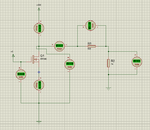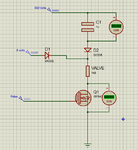upervaiz
Junior Member level 2
Hello,
I am designing a E-Mosfet (FQP3N30) as a switch. But i couldn't able to understand that, how can i design the value of drain resistance Rd.
my load is a coil valve (internal resistance is 33ohm to 70 ohm, current is 500mA) that is connected to the output of the Mosfet (drain).
Could you please tell me, how can i design my drain resistance in order to get 300V and 0V volts at the output through switching.
Thank you
I am designing a E-Mosfet (FQP3N30) as a switch. But i couldn't able to understand that, how can i design the value of drain resistance Rd.
my load is a coil valve (internal resistance is 33ohm to 70 ohm, current is 500mA) that is connected to the output of the Mosfet (drain).
Could you please tell me, how can i design my drain resistance in order to get 300V and 0V volts at the output through switching.
Thank you

